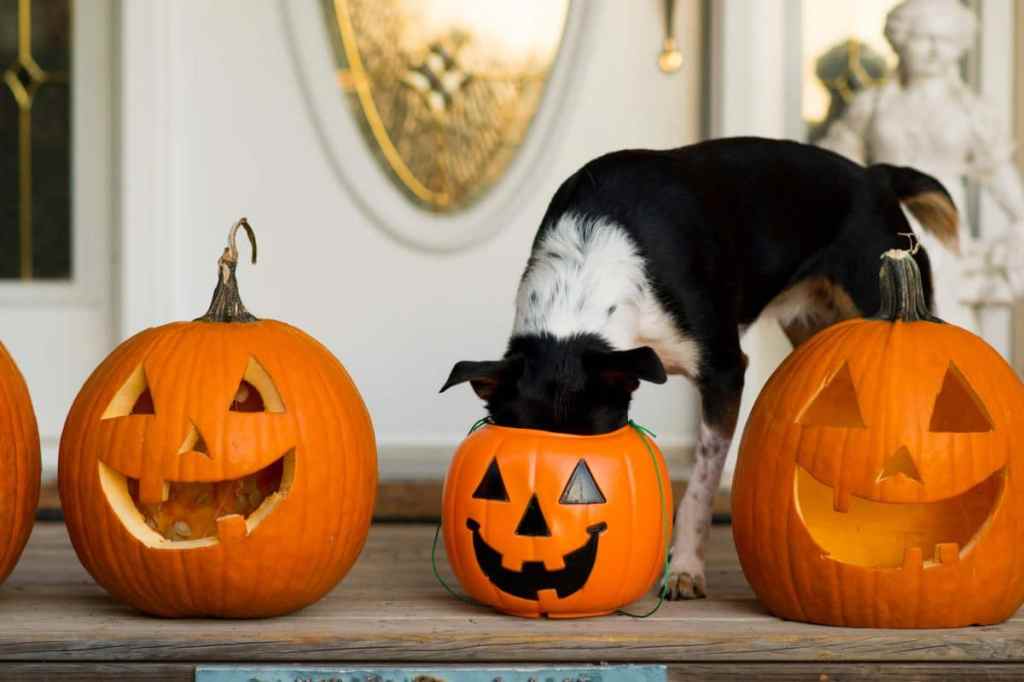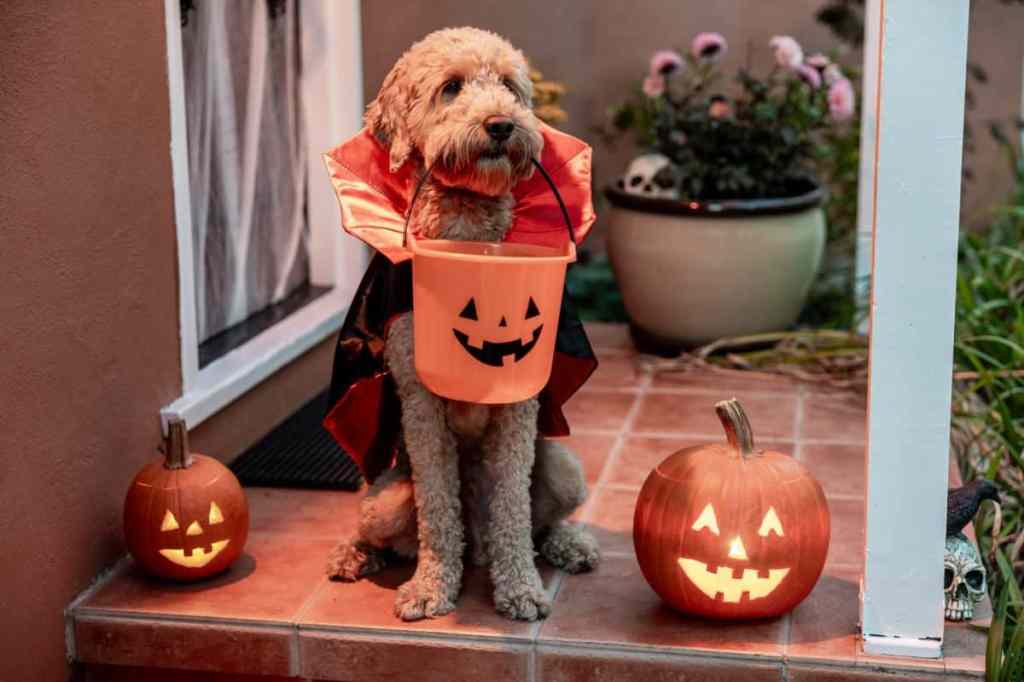When it comes to Halloween, the spookiest sight for dog parents might just be that crinkly, colorful bag of candy sitting on the counter. Believe it or not, Halloween marks the busiest week of the year for the Pet Poison Helpline, with calls about pets getting into candy spiking by 12 percent. It’s not surprising when you consider the risks. We all know chocolate can be deadly for dogs, but that’s not the only concern. Many candies are loaded with sugar and fat, which can wreak havoc on your pup’s health. And if you think sugar-free treats are a safe bet, think again: they often contain xylitol, a sugar substitute that is extremely toxic to dogs, even in tiny amounts.
So, what should you do if you find your pooch with half-chewed chocolate wrappers strewn in their wake? Don’t panic just yet! Here are some steps you can take if your dog eats Halloween candy.
Find out the type and amount of Halloween candy your dog ate

It might seem tricky to piece together what your dog ate with all those torn-up wrappers, but figuring out the type and amount of candy can make a big difference in getting them the right care. When it comes to chocolate, the main culprit is theobromine — a compound that, along with caffeine, is highly toxic to dogs because they metabolize it much more slowly than we do. And here’s the kicker: different types of chocolate have different theobromine levels, meaning some chocolates are far more dangerous than others. Here’s a rough breakdown:
- White chocolate: With about 1 mg of theobromine per ounce, white chocolate is the least toxic type. However, its high fat and sugar content can still upset your dog’s stomach.
- Milk chocolate: Contains approximately 64 mg of theobromine per ounce, making it moderately toxic. Small dogs are at risk even with relatively small amounts.
- Dark chocolate: Dark chocolate has around 160 mg of theobromine per ounce. Even a small amount can be harmful to dogs.
- Baking chocolate and cocoa powder: These are the most dangerous forms for dogs, with baking chocolate containing about 450 mg of theobromine per ounce, and cocoa powder with similarly high levels. A tiny piece or even a small spoonful can be life-threatening to a dog, no matter their size.
How to calculate chocolate toxicity in your dog
A simple way to estimate the risk is to calculate the amount of theobromine ingested. A general rule of thumb is that doses of around 20 mg of theobromine per kilogram — or 9 mg per pound — of body weight can cause mild symptoms in dogs. More severe symptoms can occur at doses above 40–50 mg per kilogram — or 18–23 mg per pound — and doses over 100 mg per kilogram — or 45 mg per pound — can be lethal.
Let’s say you have a 20-pound — about 9 kg — dog, and they eat 2 ounces of milk chocolate. To find out the risk, you multiply the ounces by the theobromine content:
2 ounces x 64 mg/ounce = 128 mg of theobromine
Now, divide the total theobromine by your dog’s weight in kilograms:
128 mg / 9 kg = ~14.2 mg/kg or 128 mg / 20 lb = ~6.4 mg/lb
In this example, your dog may experience mild symptoms like restlessness and a slightly elevated heart rate but isn’t likely to face severe toxicity. However, it’s always best to err on the side of caution. If you suspect your dog has consumed any chocolate — even in small amounts — contact your veterinarian or call the Pet Poison Helpline at (855) 764-7661 immediately.
Know the symptoms of chocolate poisoning

Not to add more spookiness to this story, but your dog may eat some chocolate or other candies out of your sight, and you may not be able to calculate their toxicity level.
Knowing the symptoms of chocolate or other forms of poisoning in your dog will help you and your vet determine what the best course of action is. Accordingly, signs of chocolate ingestion — and possibly toxicity — include:
- Vomiting
- Diarrhea
- Increased heart rate
- Restlessness
- Excessive thirst
- Seizures (in severe cases)
Now, you might be wondering how quickly these symptoms can appear. Typically, signs of chocolate poisoning can start to appear within six to 12 hours after your dog has eaten chocolate. However, this can vary based on the individual dog and the specific circumstances. Keep in mind, since darker chocolates contain higher levels of theobromine, symptoms might appear sooner compared to milk chocolate. Accordingly, the speed of onset of symptoms may also be affected by your dog’s breed size.
Why sugar-free chocolate is harmful for dogs
Most of us know that chocolate is a no-go for dogs, but did you know sugar-free candy can be just as dangerous, if not worse? This is due to a common ingredient called xylitol, otherwise known as birch sugar or wood sugar. Xylitol is a sugar substitute often found in sugar-free gum, candies, and baked goods. Not only that, you might even find it listed as an ingredient in some brands of peanut butter — a popular treat sometimes used in Halloween candies.
While xylitol might seem like a healthier option for humans, it’s quite the opposite for dogs. Even a tiny amount can trigger a rapid insulin release in a dog’s body, leading to a sharp drop in blood sugar — a condition known as hypoglycemia. This can occur within 10 to 60 minutes of ingestion and may result in symptoms like vomiting, weakness, loss of coordination, and in severe cases, seizures, liver failure, or even death. It’s easy to overlook how many foods and treats around the house might contain xylitol, especially during Halloween when there’s candy everywhere.
Watch out for nuts, caramel, and other sneaky ingredients in chocolate
Beyond the obvious risk of chocolate itself, other ingredients like nuts and caramel in candy can also be harmful. And while peanuts are generally safe for dogs in small quantities, other nuts can be a serious problem. Almonds, for example, are a common ingredient in candies like Almond Joy, and they’re not easily digestible for dogs. Consuming almonds can lead to gastrointestinal upset, with symptoms like vomiting and diarrhea, or even present a choking hazard. Similarly, hazelnuts, which are often found in gourmet chocolates, aren’t as toxic as macadamia nuts but can still trigger digestive issues and discomfort.
And there’s more to watch out for — caramel can be just as risky. This sweet, sticky treat can easily get stuck in your dog’s teeth or even become a choking hazard. Plus, with all that sugar, caramel can contribute to obesity and dental problems over time. To keep your pup safe, make sure all types of candy are stored well out of reach.
Just because your dog didn’t eat chocolate doesn’t mean they’re in the clear
Dogs aren’t picky about the type of candy they dive into, which can make Halloween treats particularly risky. Eating large amounts of candy high in fat and sugar can lead to pancreatitis in dogs. This condition is characterized by painful inflammation of the pancreas, which can cause serious complications like kidney failure and organ damage. To make matters trickier, the more severe signs of pancreatitis might not appear until two to four days after your dog’s candy feast.
If you suspect Fido got into something sugary, watch closely for symptoms like vomiting, diarrhea, abdominal pain — especially if a belly rub seems uncomfortable — and a sudden drop in appetite. If you notice any of these signs, reach out to your vet right away.
The best measure is preventative

It may be terrifying to think that a little bit of candy can do this much damage to your beloved dog, but the good news is that most of these situations are easy to avoid. If you’re handing out Halloween candy, keep the bowl up high where your pup can’t reach it or accidentally knock it over. And if you have kids who are going trick-or-treating, make sure to explain how important it is not to share any candy with your dog and to keep it out of their reach.
Don’t forget to secure your trash, too! Dogs love to rummage through wrappers, which can cause severe indigestion. On days with high candy traffic, give your pup plenty of exercise and a good meal so they’ll be content instead of curiously sniffing around for some treats.
As with any medical question or concern about your dog, be sure to contact your vet with any pet-specific questions you may have. It’s also a good idea to have the number of the nearest emergency vet clinic saved on your phone — not just for candy overindulgence, but for any other emergencies that might come up in the future.









